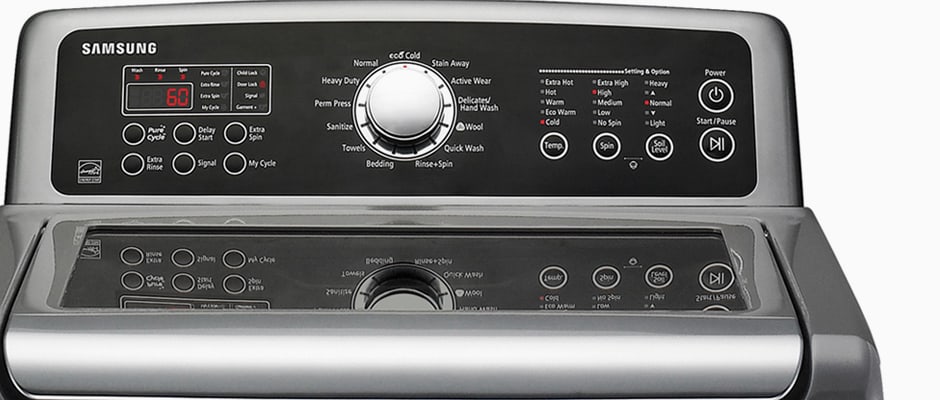Pros
Cons
Introduction
Certain serial numbers of this model may be affected by this issue. As such, we have chosen to rescind our Editors’ Choice award for this product until we have more information on Samsung’s plans to remedy the situation.
This appliance is big, feature-filled and handsome. With an MSRP of $1299, it’s also pretty pricey—though we were able to find one for sale online for under $1000. It did a decent job getting clothes clean in our tests, but was still outperformed by smaller, homelier units that cost hundreds less.
This Samsung may be a good washer, but it’s certainly not the best value.
Design & Usability
{{section_header}}{{section.name}}{{/section_header}}
Easy to use and easy to load
The {{product.model}} has movie star good looks, with a stainless exterior that impresses on the cover of product catalogs and showroom floors. Samsung offers a similar washer—the WA5471ABW—in plain white, for $100 less. Although it has an extravagant exterior, the {{product.name}} has a simple heart. It has a user-friendly control panel that's dominated by a large cycle selector knob, and each wash option has its own button. Since the panel is so large, it’s not cluttered and text is large and easy to read.
Due to its big door and large drum, the Samsung WA5471ABP is extremely easy to load too. As its a top loader, folks who have shoulder problems or who are lacking in height may find it hard to reach in and pull out heavy, wet clothes, though.
{{photo_gallery "Front Image", "Controls 1 Photo", "Controls 2 Photo", "Drawer Photo", "Lint Trap Photo", "Interior Photo", "Interior Detail Photo", "Sides Photo", "Sides Detail 1 Photo", "Side Detail 2 Photo", "Back Photo", "Back Detail Photo"}}
Performance & Features
{{section_header}}{{section.name}}{{/section_header}}
Specialty cycles take a long time, and the washer has some balancing issues.
After all of our tests, none of the {{product.name}}'s cycles stood out. The Cotton/Whites setting was the most impressive, which did almost as well removing oil-based stains as it did getting out blood, wine, and cocoa. However, the laundry emerging from the cotton test cycles did remain pretty water logged, so it might take a bit longer to dry.
There is a My Cycle setting, though, which allows a user to create their own cycle by setting spin speed, temperature, and soil level. Most higher end washing machines have this option, and that says a lot about this washer.
Efficiency ratings are where things get dicey. Run a normal wash cycle and it'll use about 26 gallons of water. That definitely won't get any awards from Greenpeace, but it's still nothing compared to some of the specialty cycles, which use a whopping 81 gallons of water to get clothes clean. If you drink the recommended 64 ounces a day, getting through 81 gallons would take you over a month, to put it in perspective.
Conclusion
{{section_header}}{{section.name}}{{/section_header}}
The {{product.name}} (MSRP $1299) is not a cheap washer.
This appliance looks and feel expensives, but it costs a lot to purchase and operate. If you need a washer with a large capacity and lots of custom wash cycles, and if you have cash to spare, the {{product.model}} is a fine washer. But if you're pinching pennies or even moderately cost conscious, you can get a washer with equal or better performance for hundreds less.
Science Introduction
{{section_header}}{{section.name}}{{/section_header}}
The {{product.name}} is a high-end machine that looks the part. The Whites cycle stood out the most. It had a strong gamut of stain removal, ranging from blood to wine. Everything else was middling on nearly all accounts. A few standout cycles don't make up for a nearly $300 price difference between the Samsung and its mid-range competitors.
Performance Tests: Cleaning
{{section_header}}{{section.name}}{{/section_header}}
Style over substance
Each washer we test goes through a gauntlet of strict procedures. For cleaning performance, we use stain strips. These standardized strips of cloth have patches coated in household substances like cocoa and oil. They are packed in eight-pound loads of test laundry and subjected to a wash cycle. When the buzzer sounds, we take them out and scan them under a light spectrometer.
That's how we determined that the Whites cycle was the best the {{product.name}} had to offer. Other cycles, like the Quick Wash, couldn't measure up.
{{photo_gallery "Science Section 1 Images"}}
Performance Tests: Efficiency
{{section_header}}{{section.name}}{{/section_header}}
Not fish approved
When a new washer comes in, we hook it up to water and watt meters. We run through every cycle that it has to offer and record the amount of resources it consumes.
That's how we learned that the {{product.name}} was a thirsty machine; being a top-loader isn't conducive to conservation because laundry floats, rather than rolls, in water. However, why does the Towels cycle require over 80 gallons to complete? What does Samsung think we use our towels for? Even the cycle labeled Eco Cold used nearly 51 gallons of water. All this water isn't free. Combined with moderate electricity use, we estimate this washer to have a $90 yearly running cost—that is very high. This washer is definitely not fish approved.
{{photo_gallery "Science Section 2 Images"}}
Performance Tests: Water Retention
{{section_header}}{{section.name}}{{/section_header}}
We like appliances that are team players.
We weigh a test load before and after a wash cycle. Starting around eight pounds, we can then determine how much water is retained. This is important, because the less water your laundry retains, the less work your dryer will get stuck with. Though the {{product.name}}s White's cycle had excellent cleaning performance, it stumbled when it came to water retention. Loads that underwent the Whites cycle came out with 68% of their weight in water. We'd liked to see those numbers closer to 50% to award a gold star. Overall, this washer was moderately good at spinning out extra water.
{{photo_gallery "Science Section 3 Images"}}
Meet the tester
Keith was the Editor in Chief of Reviewed's appliance and automotive sites. His work has appeared in publications such as Wired, Car & Driver, and CityLab.
Checking our work.
Our team is here to help you buy the best stuff and love what you own. Our writers, editors, and experts obsess over the products we cover to make sure you're confident and satisfied. Have a different opinion about something we recommend? Email us and we'll compare notes.
Shoot us an email

